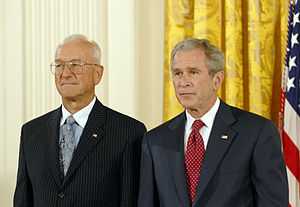Paul G. Kaminski

Paul G. Kaminski (born September 16, 1942) is a technologist and former U.S. government official, best known for his leading role in the development of stealth aircraft.
Early life
Kaminski was born in Cleveland, OH. He received his B.S. degree from the Air Force Academy in 1964. Later, he earned MS degrees in Aeronautics and Astronautics and in Electrical Engineering from MIT, and, in 1971, a Ph.D. in Aeronautics and Astronautics from Stanford University.
Military and government career
Kaminski served 20 years on active duty in the U.S. Air Force, mostly within Air Force Systems Command, rising to the rank of full colonel. Among other Air Force assignments, Kaminski was responsible for test and evaluation of inertial guidance components for the LGM-30 Minuteman missile and terminal guidance systems for the first U.S. precision-guided munitions.[1]
In 1971 Kaminski was assigned to the National Reconnaissance Office and based in Los Angeles. There he led work on a space system and related "unconventional imaging" technology, including the flying of prototypes on low and high altitude aircraft. This assignment, possibly related to the Lacrosse radar satellite, continued until 1976[1][2]
In 1976-77, Kaminski attended the Industrial College of the Armed Forces. During that time he met Under Secretary of Defense William J. Perry, and became Perry's Special Assistant in 1977. One of his assignments was to assess early work on stealth technology. Kaminski recommended going ahead with the creation of a large program that included, already by 1978, the experimental Have Blue airplane.[2][3]
When Perry left government in 1981, Kaminski became Director for Low Observables Technology, with responsibility for overseeing the development, production and fielding of major stealth aircraft systems such as the F-117 (already well underway at the time) and Northrop Grumman B-2 Spirit (which was just being defined), along with an advanced, stealthy cruise missile and other programs.[2] Kaminski held this position from 1981 to 1984.[1]
Kaminski left the Air Force after 20 years service in 1984. After a decade in the private sector, he returned to government in 1994 as Under Secretary of Defense (Acquisition and Technology) from 1994 to 1997, under by-then Secretary of Defense William J. Perry. In this role, he was responsible for activities with an aggregate annual budget exceeding $100 billion. He is credited with starting the "Revolution in Business Affairs", a Pentagon acquisition reform initiative that was continued by his successor Jacques Gansler.[4]
Later career
In his first period away from government work (1984-1994), Kaminski joined Perry in Technology Strategies and Alliances, an investment banking and technology strategy business, of which Kaminski eventually became Chairman and Chief Executive Officer.[2] Then and subsequently, he has served as a consultant and advisor to a wide variety of government agencies and as chairman, director or trustee of several defense and technology oriented companies.[1][5]
Kaminski has been a member of the President's Intelligence Advisory Board, Chairman of the Defense Science Board, and has served as a member of the DNI's Senior Advisory Group, FBI Director's Advisory Board, the Senate Select Committee on Intelligence Technical Advisory Board, the National Academies Air Force Studies Board, and the Atlantic Council. He is a member of the National Academy of Engineering, a Fellow of the Institute for Electrical and Electronics Engineers, and a Fellow of the American Institute of Aeronautics & Astronautics.[1][5]
Kaminski is or has been Chairman of the Board of the RAND Corporation, Exostar LLC, and HRL (formerly Hughes Research Labs), and as a Director of General Dynamics, Bay Microsystems, CoVant Technologies, and the USAF Academy Endowment. He has served as an advisor to the Johns Hopkins Applied Physics Lab and MIT Lincoln Laboratory.[1][5][6] He has been the Chief Executive Officer and President of Technovation Inc. since 1997.[7]
Kaminski has authored publications dealing with inertial and terminal guidance system performance, simulation techniques, Kalman filtering and numerical techniques applied to estimation problems.[1]
Honors and awards
Kaminski has received the following awards: National Medal of Technology 2006, Department of Defense Medal for Distinguished Public Service (3 awards), Defense Distinguished Service Medal, Director of Central Intelligence Director's Award, Defense Intelligence Agency Director's Award, Legion of Merit with Oak Leaf Cluster, Air Force Academy 2002 Distinguished Graduate Award, the International Strategic Studies Association Stefan T. Possony Medal for Outstanding Contributions to Strategic Progress through Science and Technology, the AOC Gold Medal, the Netherlands Medal of Merit in Gold, the French Republic Legion d'Honneur, and the Air Force Systems Command Scientific Achievement Award. He has been recognized as a Pioneer of National Reconnaissance and a Pioneer of Stealth.[1][8] In 2015 he received the IEEE Simon Ramo Medal
References
- ↑ 1.0 1.1 1.2 1.3 1.4 1.5 1.6 1.7 U.S. Missile Defense Agency, "Dr. Paul G. Kaminski Former Under Secretary of Defense 2011 Ronald Reagan Award Winner" (2011)
- ↑ 2.0 2.1 2.2 2.3 Stanford University School of Engineering, "Alumni Profile: Paul Kaminski (PhD 1971 AA)"
- ↑ David C. Aronstein and Albert C. Piccirillo, Have Blue and the F-117A: evolution of the "Stealth Fighter" (American Institute of Aeronautics and Astronautics, 1997).
- ↑ "Gansler Names Study Group to Lay Groundwork for Conversion to Price-Based Approach to Acquisition" Federal Contracts Report, vol. 70, p. 491 (1998).
- ↑ 5.0 5.1 5.2 NNDB, "Paul G. Kaminski"
- ↑ Rand Corporation, "Paul G. Kaminski Elected To Lead RAND Corporation Board of Trustees" (May 19, 2009)
- ↑ "Bloomberg BusinessWeek"
- ↑ Hon. Frank R. Wolf, "FBI Director Expands Science and Technology Board", Congressional Record, vol. 151, pt. 17, pg. 23064 (October 18, 1995).
External links
![]() This article incorporates public domain material from websites or documents of the U.S. Missile Defense Agency.
This article incorporates public domain material from websites or documents of the U.S. Missile Defense Agency.
| ||||||